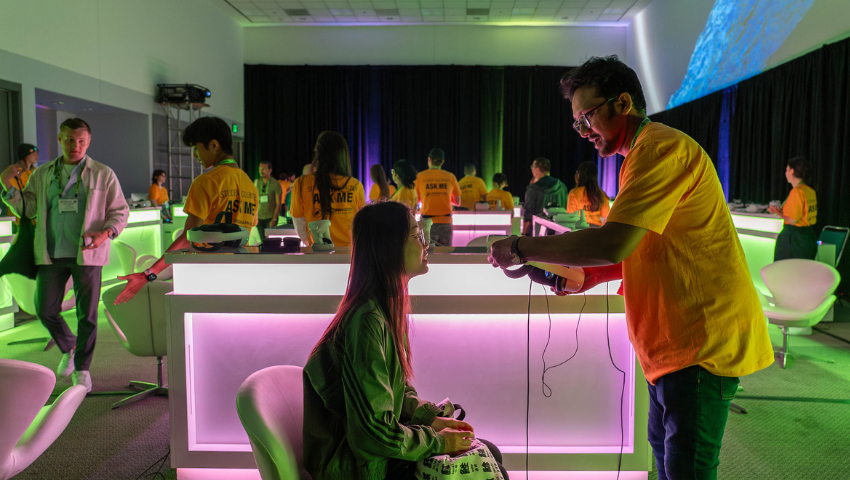Photo: “Doors,” David-Alexandre Chanel, Romain Constant: THÉORIZ Studio
by Jessica Sommerville
These days, students who wish to pursue a career in animation or VFX have lot of options when it comes to choosing education pathways. Universities, specialty, trade, online schools, mentoring or private lessons – the world is your oyster. There are so many options it may seem overwhelming.
We had the opportunity to sit down with the directors of four top animation schools who shared insights about their institutions and provided useful tips for those planning to go into the field of animation.
Four Schools
We spoke with Jon Macey, the Department director of the computer animation course at Bournemouth University (BU), Andreas Hykade the director of the Animationsinstitut at Filmakademie Baden-Württemberg, Megan Ring and Edward Quintero who run Mold 3D Academy, and Andrew Silke founder of Create 3D Characters.
BU claims to be “recognized as the only Centre for Excellence in Media Practice in the UK.” The university appears in the top 10 for the Autodesk Rookies animation school rankings for 2017. They have both technical and artistic degrees. According to Macey, “many of our graduates now work at big VFX/games companies and we have Oscar Winners (both VFX and Technical) amongst our alumni.”
Filmakademie is a specialized film school, and it is ranked number two on the Autodesk Rookies animation school rankings for 2017. Its director, Andreas Hykade, tells us that “strong creative development, combined with market relevant skills is what makes the studies at Animationsinstitut so valuable.”
Mold 3D is an online school with classes taught by top professionals with a focus on 3D modeling, sculpting, and emerging technologies like 3D Printing/prototyping and VR/AR. They focus less on theory and software, “and more on working to improve yourself as an artist.”
Create 3D Characters is an online (or in person if you live in Sydney) 3D generalist course with a private mentoring component. Andrew, an industry veteran and an animator and previz artist by trade, teaches classes in modeling, surfacing, lighting, rigging and animation.
How do I choose an educational setting when there are so many options?
It can be overwhelming, but begin by knowing yourself and what type of student you are. Do you crave structure or freedom? Are you artistic or academic, or are you a combination of both? For instance, consider universities. They are typically the most structured of education pathways. Curricula are in place and courses are divided into theory and practical components.
In the case of Bournemouth University, they balance theory and practice, and they have strong ties with the industry. Macey believes that the undergraduate courses are a good way to get your foot in the door. “We have a “Masterclass” unit on the undergraduate course that has industry set brief with input from people working in the industry so the students can work on real life projects.”
As for postgraduate degrees, the programs at BU allow those with existing experience to apply their knowledge from a related field to animation or VFX. For example, the MSc course introduces programmers, mathematicians, engineers and physics graduates to CGI and more advanced graphics programming so they can apply their existing knowledge to the area.
Specialised and trade schools are often based in practical rather than theoretical studies, and have an open course structure. Filmakademie abides by the idea of “learn by doing” across all of their courses. Hykade expands on this sentiment explaining: “Our project-oriented and flexible curriculum gives our students a lot of creative freedom and the opportunity to develop their own artistic style. Creative minds who are open to explore the versatile course program, while also taking the chance to adapt it to their own needs, will make the most of their time at Animationsinstitut.” He also suggests that students should be self reliant, “we do not have a modular curriculum that tells our students exactly what to do at what time during their studies.”
As for online schools, mentoring or private lessons, a large percentage of students who enroll in these courses are working professionals or have already completed prior studies and may have a diploma or degree. Megan and Edward from Mold 3D explain that their courses benefit students who “don’t have access to experienced instructors or are working professionals and busy artists who don’t have the time to take classes at a physical location. What sets Mold3D Academy apart is that we focus on hiring professionals currently working at top studios such as Disney Feature Animation and Dreamworks.” They tell us that most students who seek out their courses “simply want to improve on a specific skill set or continue building their portfolio.”
While Mold 3D and other online schools are extremely specialized, which is amazing if you want to enhance your abilities in a specific area, there may be students who want to expand their generalist 3D skillset with private mentoring. According to Silke, “Our mentoring courses are targeted to the industry and to the individual student. I’m also more of a bridging school, since most students have already attended training before coming to me.”
He goes on to say, “At university, you hand in your assignment and it’s is done. Private mentoring is different in that there are no assignments, we work on your skills and show reel. We keep going until you understand the concepts properly, and you only move on when you can demonstrate that. Students graduate when they get a job.”
Silke believes that since the contact hours are low, students who are self motivated benefit most from his classes.
Other Things to Consider
Universities and trade schools can be expensive. Andrew Silke believes that one benefit of mentoring is its cost-effectiveness. One year of mentoring costs around 10% of a private schools fees. The same is true of Mold 3D’s online courses.
However while University can be expensive, they are accredited institutions and you will receive a degree on completion (some trade schools offer degrees, others only diplomas). Though it is not a necessity if you are being sponsored, having a degree can be a big benefit if you wish to work abroad. It can heighten the likelihood of obtaining a visa, or at least speed along the process. Also, if you wish to go down the academic or research path, having a degree is essential.
Universities and Trade schools may also have access to industry standard software and hardware that you wouldn’t likely have in your home office. Macey tells us that at BU, “We use industry standard tools such as Maya, Houdini, and Nuke, and renderers such as VRay and Renderman. Most of our labs use Linux-based systems with dual boot to Windows for things like Z Brush, Photoshop and Unreal Engine for Games.”
Silke believes students should try to learn which jobs are currently in demand within the industry. For instance, there are far fewer jobs available for character sculptors than for environment or hard surface modelers. “Students are generally influenced by social media and Art Station but that’s not the industry. Most of the assets [in demand] are background props, environments or products.”
The lesson: be open to possibilities and explore all your options.
A great way to discover your path to a career in computer graphics is to attend SIGGRAPH 2018 in Vancover, British Columbia. The conference takes place 12-16, August 2018 and registration is open now!



